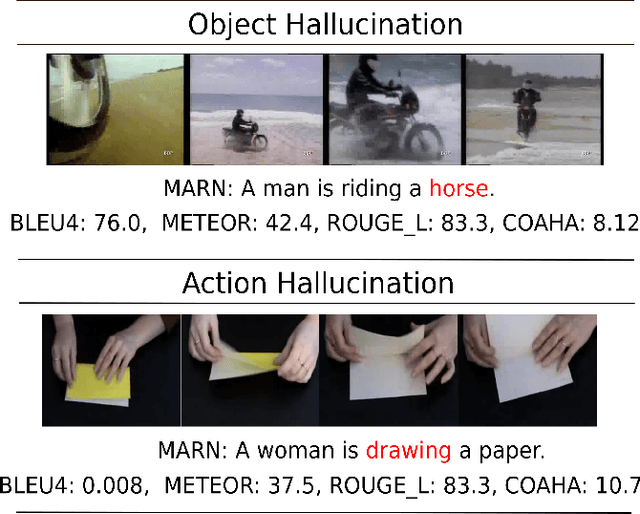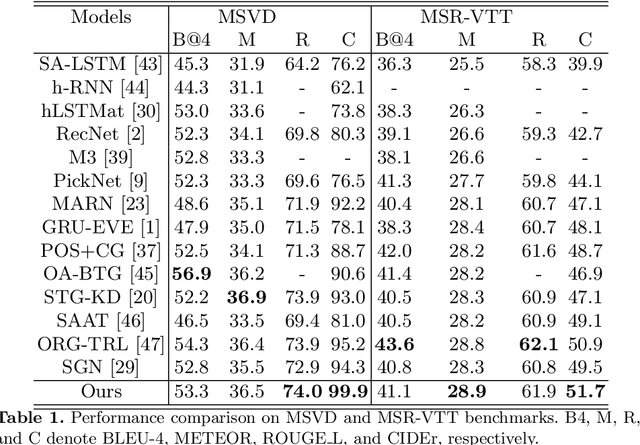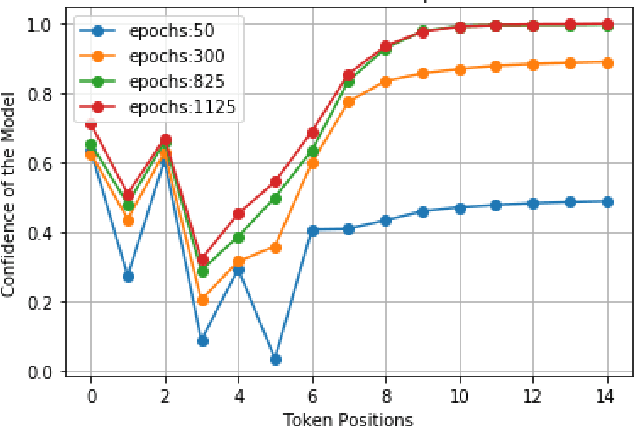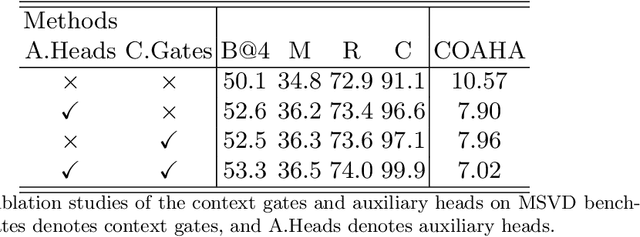Partha Pratim Mohanta
Thinking Hallucination for Video Captioning
Sep 28, 2022



Abstract:With the advent of rich visual representations and pre-trained language models, video captioning has seen continuous improvement over time. Despite the performance improvement, video captioning models are prone to hallucination. Hallucination refers to the generation of highly pathological descriptions that are detached from the source material. In video captioning, there are two kinds of hallucination: object and action hallucination. Instead of endeavoring to learn better representations of a video, in this work, we investigate the fundamental sources of the hallucination problem. We identify three main factors: (i) inadequate visual features extracted from pre-trained models, (ii) improper influences of source and target contexts during multi-modal fusion, and (iii) exposure bias in the training strategy. To alleviate these problems, we propose two robust solutions: (a) the introduction of auxiliary heads trained in multi-label settings on top of the extracted visual features and (b) the addition of context gates, which dynamically select the features during fusion. The standard evaluation metrics for video captioning measures similarity with ground truth captions and do not adequately capture object and action relevance. To this end, we propose a new metric, COAHA (caption object and action hallucination assessment), which assesses the degree of hallucination. Our method achieves state-of-the-art performance on the MSR-Video to Text (MSR-VTT) and the Microsoft Research Video Description Corpus (MSVD) datasets, especially by a massive margin in CIDEr score.
Recent Trends in 2D Object Detection and Applications in Video Event Recognition
Feb 07, 2022Abstract:Object detection serves as a significant step in improving performance of complex downstream computer vision tasks. It has been extensively studied for many years now and current state-of-the-art 2D object detection techniques proffer superlative results even in complex images. In this chapter, we discuss the geometry-based pioneering works in object detection, followed by the recent breakthroughs that employ deep learning. Some of these use a monolithic architecture that takes a RGB image as input and passes it to a feed-forward ConvNet or vision Transformer. These methods, thereby predict class-probability and bounding-box coordinates, all in a single unified pipeline. Two-stage architectures on the other hand, first generate region proposals and then feed it to a CNN to extract features and predict object category and bounding-box. We also elaborate upon the applications of object detection in video event recognition, to achieve better fine-grained video classification performance. Further, we highlight recent datasets for 2D object detection both in images and videos, and present a comparative performance summary of various state-of-the-art object detection techniques.
Unsupervised Action Localization Crop in Video Retargeting for 3D ConvNets
Nov 22, 2021



Abstract:Untrimmed videos on social media or those captured by robots and surveillance cameras are of varied aspect ratios. However, 3D CNNs usually require as input a square-shaped video, whose spatial dimension is smaller than the original. Random- or center-cropping may leave out the video's subject altogether. To address this, we propose an unsupervised video cropping approach by shaping this as a retargeting and video-to-video synthesis problem. The synthesized video maintains a 1:1 aspect ratio, is smaller in size and is targeted at video-subject(s) throughout the entire duration. First, action localization is performed on each frame by identifying patches with homogeneous motion patterns. Thus, a single salient patch is pinpointed per frame. But to avoid viewpoint jitters and flickering, any inter-frame scale or position changes among the patches should be performed gradually over time. This issue is addressed with a polyBezier fitting in 3D space that passes through some chosen pivot timestamps and whose shape is influenced by the in-between control timestamps. To corroborate the effectiveness of the proposed method, we evaluate the video classification task by comparing our dynamic cropping technique with random cropping on three benchmark datasets, viz. UCF-101, HMDB-51 and ActivityNet v1.3. The clip and top-1 accuracy for video classification after our cropping, outperform 3D CNN performances for same-sized random-crop inputs, also surpassing some larger random-crop sizes.
Event and Activity Recognition in Video Surveillance for Cyber-Physical Systems
Nov 03, 2021



Abstract:This chapter aims to aid the development of Cyber-Physical Systems (CPS) in automated understanding of events and activities in various applications of video-surveillance. These events are mostly captured by drones, CCTVs or novice and unskilled individuals on low-end devices. Being unconstrained, these videos are immensely challenging due to a number of quality factors. We present an extensive account of the various approaches taken to solve the problem over the years. This ranges from methods as early as Structure from Motion (SFM) based approaches to recent solution frameworks involving deep neural networks. We show that the long-term motion patterns alone play a pivotal role in the task of recognizing an event. Consequently each video is significantly represented by a fixed number of key-frames using a graph-based approach. Only the temporal features are exploited using a hybrid Convolutional Neural Network (CNN) + Recurrent Neural Network (RNN) architecture. The results we obtain are encouraging as they outperform standard temporal CNNs and are at par with those using spatial information along with motion cues. Further exploring multistream models, we conceive a multi-tier fusion strategy for the spatial and temporal wings of a network. A consolidated representation of the respective individual prediction vectors on video and frame levels is obtained using a biased conflation technique. The fusion strategy endows us with greater rise in precision on each stage as compared to the state-of-the-art methods, and thus a powerful consensus is achieved in classification. Results are recorded on four benchmark datasets widely used in the domain of action recognition, namely CCV, HMDB, UCF-101 and KCV. It is inferable that focusing on better classification of the video sequences certainly leads to robust actuation of a system designed for event surveillance and object cum activity tracking.
* This is a preprint of the chapter:S Bhaumik, P Jana, PP Mohanta, Event and Activity Recognition in Video Surveillance for Cyber-Physical Systems, published in Emergence of Cyber Physical System.., edited by KK Singh et al, 2021, Springer reproduced with permission of Springer Nature Switzerland AG. The final authenticated version is available online at http://dx.doi.org/10.1007/978-3-030-66222-6_4
Boosting Video Captioning with Dynamic Loss Network
Aug 02, 2021



Abstract:Video captioning is one of the challenging problems at the intersection of vision and language, having many real-life applications in video retrieval, video surveillance, assisting visually challenged people, Human-machine interface, and many more. Recent deep learning-based methods have shown promising results but are still on the lower side than other vision tasks (such as image classification, object detection). A significant drawback with existing video captioning methods is that they are optimized over cross-entropy loss function, which is uncorrelated to the de facto evaluation metrics (BLEU, METEOR, CIDER, ROUGE).In other words, cross-entropy is not a proper surrogate of the true loss function for video captioning. This paper addresses the drawback by introducing a dynamic loss network (DLN), which provides an additional feedback signal that directly reflects the evaluation metrics. Our results on Microsoft Research Video Description Corpus (MSVD) and MSR-Video to Text (MSRVTT) datasets outperform previous methods.
 Add to Chrome
Add to Chrome Add to Firefox
Add to Firefox Add to Edge
Add to Edge